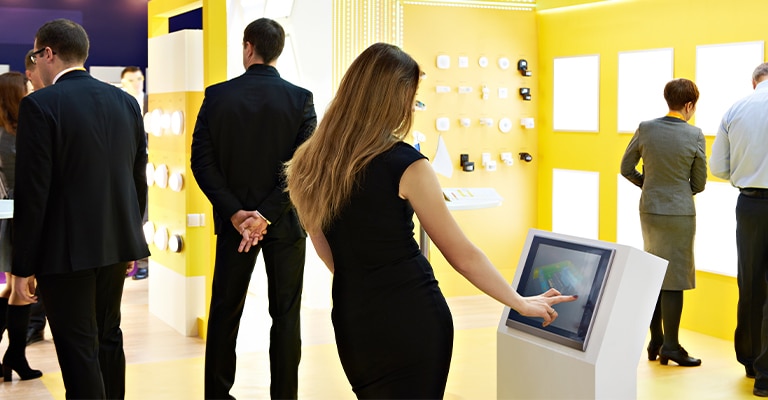A tradeshow display needs to fulfill a handful of requirements. It needs to have ample room for people to move about because more space means more potential clients. An effective display also needs to be informative and practical. Furthermore, an exhibit should also be interesting and engaging. Lastly, your display must be flexible. This final characteristic is why adaptable displays are such a valuable tool for any tradeshow professional.
One way to develop an adaptable exhibit is to design it so that you can set it up in booth spaces of varying sizes. Flexible exhibits allow you to use your materials more than once. In short, your investment works harder for you over a longer period of time.
What is an Adaptable Display?

Most booths, especially custom booths, are designed for a specific footprint, which means their size and dimensions are fixed. On the other hand, an adaptable display allows you to configure it in different ways to fit various footprints.
You can design custom and modular displays with flexibility in mind. You can add or remove wall and display components as needed with modular displays and you can design custom booths so they can adapt to different size footprints and uses.
Last, but not least, flexibility is important. A flexible layout allows a booth to work in different sizes and in different locations too. For example, if your display is positioned at the end of an aisle, you’ll want a different layout than if your display is in the middle of an aisle or flush against a wall. Adjusting the layout of your adaptable display according to your location helps make your booth more visible on the show floor, which, in turn, helps boost traffic. Once inside, the layout helps direct the flow of traffic.
Why Build an Adaptable Display?
There are many benefits to building an adaptable display:
- The size of your booth will not limit your growth since your booth will grow with your needs
- You can use it at multiple tradeshows since you can adjust to different size spaces. This reduces your cost-per-use and helps you get more bang for your buck
- As you attend more events, people will recognize your booth, which boosts your brand recognition
How to Incorporate Flexibility Into Your Tradeshow Display

In order to design an adaptable display, you need to first ask yourself a few questions:
1.) What Footprints Do You Need to Accommodate?
The floor layout is the primary consideration here. However, you cannot neglect the vertical dimension. The amount of vertical space you have to work with changes depending on:
- The size of your booth
- Your location on the show floor
If you have a larger footprint, you can take advantage of the extra vertical space with canopies and hanging signs, which make your exhibit visible from a greater distance.
2.) What Features Should You Include in Each Size?
This one is more difficult to answer. You need to think in terms of both general needs and the needs specific to each show you plan to attend. The features you want at one show depend on your goals for that show, so it’s more complicated than simply including a static list of features.
One solution is to develop an adaptable display with interchangeable features that all work within a specific footprint. Another option is to craft a custom booth that can adapt to two or three different sizes and layouts.
A few options for adaptable booths include:
A.) Modular Displays
Modular designs incorporate individual structural and display components. These booth setups are inherently flexible. Furthermore, they’re great because adding new components is easy as your exhibit expands with time.
Modular designs are ideal for a wide range of budgets and purposes. They’re especially effective if you plan to attend shows in different markets since you can exchange different components depending on the show. You can also opt to employ modular components with multiple graphic panels that you can change based on the event at hand.
B.) Custom Adaptable Displays
Some custom displays are designed for a specific footprint. However, it’s possible to craft custom designs that you can adjust to different sizes and layouts. Removable wall panels, adjustable canopies, and similar design features ensure that your booth is on point at every show. A custom exhibit typically requires a larger budget. However, the impact on future clients is worth every penny due to the traffic and press it garners.
ProExhibits developed a highly customized adjustable booth for Stikwood. The exhibit portrayed a barn and was made of interlocking panels. Besides its aesthetic appeal, it was highly adaptable due to the use of interlocking panels and which allowed it to fit most footprints by simply adding or removing panels.
C.) Tension Fabric Displays
Tension fabric displays consist of fabric stretched over an adjustable frame, which provides a seamless, complete look with clean, modern lines. These displays are flexible and budget-friendly since you can change the shape and size by simply increasing or decreasing the size of the frame. You should consider tension fabric displays if you’re on a tight budget or you don’t require an elaborate display.
Futureproof Your Booth with an Adaptable Design
A tradeshow display isn’t a small investment, so an adaptable display is the most logical option since it works with a wide range of footprints and sizes. Furthermore, adaptable displays allow you to use your booth at a wider range of events, decreasing your cost-per-use and making your tradeshow marketing efforts more cost-effective.




